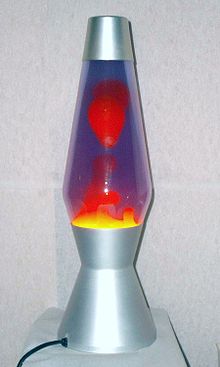- Diapir
-
For the undergarment, see Diaper.
 An original Mathmos Astro lava lamp. A lava lamp illustrates Rayleigh–Taylor instability-type diapirism in which the tectonic stresses are low.
An original Mathmos Astro lava lamp. A lava lamp illustrates Rayleigh–Taylor instability-type diapirism in which the tectonic stresses are low.
A diapir (
 /ˈdaɪ.əpɪər/;[1] French, from Greek diapeirein, to pierce through) is a type of intrusion in which a more mobile and ductily-deformable material is forced into brittle overlying rocks. Depending on the tectonic environment, diapirs can range from idealized mushroom-shaped Rayleigh-Taylor instability-type structures in regions with low tectonic stress such as in the Gulf of Mexico to narrow dikes of material that move along tectonically-induced fractures in surrounding rock. The term was introduced by the Romanian geologist Ludovic Mrazek, who was the first to understand the principle of salt intrusion and plasticity. The term "diapir" may be applied to igneous structures, but it is more commonly applied to non-igneous, relatively cold materials, such as salt domes and mud diapirs.
/ˈdaɪ.əpɪər/;[1] French, from Greek diapeirein, to pierce through) is a type of intrusion in which a more mobile and ductily-deformable material is forced into brittle overlying rocks. Depending on the tectonic environment, diapirs can range from idealized mushroom-shaped Rayleigh-Taylor instability-type structures in regions with low tectonic stress such as in the Gulf of Mexico to narrow dikes of material that move along tectonically-induced fractures in surrounding rock. The term was introduced by the Romanian geologist Ludovic Mrazek, who was the first to understand the principle of salt intrusion and plasticity. The term "diapir" may be applied to igneous structures, but it is more commonly applied to non-igneous, relatively cold materials, such as salt domes and mud diapirs.In addition to Earth-based observations, diapirism is thought to occur on Jupiter's moon Europa, Saturn's moon Enceladus, and Uranus's moon Miranda.[2]
Diapirs commonly intrude vertically upward along fractures or zones of structural weakness through denser overlying rocks because of density contrast between a less dense, lower rock mass and overlying denser rocks.[citation needed] The density contrast manifests as a force of buoyancy. The process is known as diapirism. The resulting structures are also referred to as piercement structures.[citation needed]
In the process, segments of the existing strata can be disconnected and pushed upwards. While moving higher, they retain much of their original properties such as pressure, which can be significantly different from that of the shallower strata they get pushed into. Such overpressured Floaters pose a significant risk when trying to drill through them. There is an analogy to a Galilean thermometer.[3]
Rock types such as evaporitic salt deposits, and gas charged muds are potential sources of diapirs. Diapirs also form in the earth's mantle when a sufficient mass of hot, less dense magma assembles. Diapirism in the mantle is thought to be associated with the development of large igneous provinces and some mantle plumes.
Explosive, hot volatile rich magma or volcanic eruptions are referred to generally as diatremes. Diatremes are not usually associated with diapirs, as they are small-volume magmas which ascend by volatile plumes, not by density contrast with the surrounding mantle.
Economic importance of diapirs
Diapirs or piercement structures are structures resulting from the penetration of overlaying material. By pushing upward and piercing overlying rock layers, diapirs can form anticlines, salt domes and other structures capable of trapping petroleum and natural gas. Igneous intrusions themselves are typically too hot to allow the preservation of preexisting hydrocarbons.[4]
References
- ^ American Heritage Dictionary of the English Language (Fourth Edition. Houghton Mifflin, 2000). [1].
- ^ Cassini Imaging Central Laboratory for Operations, Enceladus Rev 80 Flyby: Aug 11 '08. Retrieved 2008-08-15.
- ^ Don L Anderson (2007). "The eclogite engine: Chemical geodynamics as a Galileo thermometer". In Gillian R. Foulger, Donna M. Jurdy. Plates, plumes, and planetary processes; Volume 430 of Special Papers. American Geological Society. ISBN 0813724309. http://books.google.com/books?id=l9a7tIJBYbkC&pg=PA47.
- ^ Schlumberger Oilfield Glossary, on-line at [2]. Retrieved 2008-08-15.
See also
Categories:- Economic geology
- Structural geology
- Geological processes
- Structure of the Earth
- Intrusions
Wikimedia Foundation. 2010.

